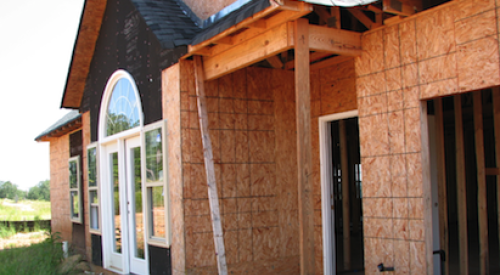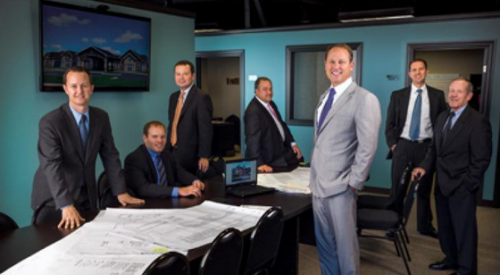|
Webb's first target: sales, because nothing is more important than bringing in the bucks. When Webb tapped Bill Probert to run sales and marketing, he committed to a revolutionary change in the sales process, which every builder selling houses to the general public should see and understand before heading into the new year.
"We bring in the best people, lay out a process that provides a flexible framework for them to work in, measure the hell out of it and then figure out how to change it to make it better," Webb says. In the sales process, Probert and his team did their homework and concluded that most builders begin marketing with the wrong goals in mind because they have an erroneous idea of their competition.
Probert puts it this way: "When people are looking to buy a home - new or resale - there's another option: staying put. If you're selling move-up houses, as we are, you not only have to compete with other new home builders and the resale market, you also have to entice people out of just fixing up the house they already own."
Design is a major component of enticement, of course, but Probert finds that all new home builders place major obstacles in the path of house hunters. "It's just no fun at all," he says. "Buying resale is a much easier process. When we talked to our customers about the relative merits of new versus used, they told us one advantage for resale is that you can enjoy your house immediately. In new construction, the neighborhood is not done. They don't enjoy their new carpet and flooring when the dog comes in from the back yard and tracks mud all over it.
'Advantage' Marketing
The "Advantage" marketing program is John Laing Homes' key competitive edge, affecting virtually every aspect of operations. It's Bill Probert's baby, a marketing approach he developed specifically to overcome down markets (such as Denver in recent months) but one with surprising strength in hot markets (such as California for the past five years).
The first thing you likely will notice is the tremendous number of direct mail pieces and the relatively light volume of traditional newspaper, radio and outdoor advertisements. Probert's goal is to identify "A" prospects for a community much sooner, while design still is going on, and then build relationships with them through numerous "touches" right through the buying process and into homeownership before eventually asking for prospect referrals.
"Our initial focus is on lead generation," Probert says. "How do we get people's attention? We start as early as possible with on-site signage and positions on our Web site, trying to capture attention, hold it and ask for a response. We want to get those who are really in the market and interested in the community attributes we describe to contact us and give us permission to market especially to them."
Most builders do what Probert calls "interruption marketing": display ads and radio to generate traffic to the site, and if that fails, incentives to coax a response. "They're desperate campaigns," he says.
Permission marketing is subtler, based on the premise that there are always people in the market for a new home, especially one with the attributes of the design gem Laing soon will bring to the particular location. The goal is early identification of the 10% to 15% of the market comprising "A" prospects for that site and product.
"Then we try to establish an ongoing relationship, well before models grand-open," Probert says. Laing already knows these buyers well through research. The product is designed for a specific buyer profile. Laing tempts them with teasers that show how perfectly the community's attributes fit them: "Now please, just step forward and let us show you the house we have designed especially for you!"
Probert won't allow pre-selling before models open. "We see very low option sales when we don't demonstrate the options in the models," he says. "Pricing is 2% to 5% lower on pre-sales. Why do that? We decided we don't want them to see the bride until she's ready to be unveiled."
|
|
|
The direct mail pieces ask prospects to join the Advantage program, which offers preview opportunities at special events before the grand opening. "We know we'll get 10% to 15% response," Probert says, acknowledging that in hot markets it's often much higher. "The 'A' prospects are where we put our energy to get the best return on our investment, but we don't forget about the 'B' list. Once the models are open, our home counselors [sales agents] take over the relationship with the 'A's, and marketing uses our computerized customer relationship management program to continue to pump communications to the 'B's, with the goal to push them into the 'A's. We are always asking people to step out of the crowd to join the Advantage program."
Early in the program, the goal is prospect identification. Later, it's pros-pect retention. Toward that end, Laing stages events such as a "dusty shoe" tour of model homes during framing, four to six weeks before the grand opening. When a large group of people shows up, they suddenly perceive that this is a high-demand product. "Even in a down market like Denver, people are in the market for a home, looking for a place and a reason to buy," Probert says. "Incentives give you a reason not to buy: The $10,000 discount this week may be $15,000 next week. Dusty shoe does just the opposite."
Home counselors call Advantage members to invite them to the tours, using carefully scripted pitches: "I'm so excited to get hold of you today! We really want you to come out and see these homes. They're going to be just beautiful, and they're really designed for people just like you. This will also give you a chance to meet a lot of people who could be your future neighbors ..."
Laing knows that in the resale market, people buy neighborhood first, home second. Why not create a similar experience with a new neighborhood? Laing sends Advantage members "Night on the Town" gift certificates for restaurants in the project's area as well as information about local schools, museums and cultural activities. The goal is to bond members to the community.
Most builders concentrate their time and efforts on "A" prospects in the sales office. Laing does it much earlier, in its marketing campaigns.
"Traditional marketing is much more expensive," Probert contends. "What we're doing is reallocating dollars toward building relationships. If we already know our prospects, we don't have to keep spending money to find new ones."
Finding Disconnects
Probert and his divisional sales and marketing vice presidents formed teams to look for what he calls disconnects in the sales process, areas where JLH was not meeting expectations, because that "creates an opportunity to really wow people if you suddenly go beyond those expectations." They conducted a series of workshops and talked to people who had bought homes from JLH and those in the buying process.
They found one disconnect in the options and selections process. "The way we asked people to make choices matched our building process, not the way buyers want to make decisions," Probert says. "We put cutoffs in there according to when we need the information to build the house. For instance, we asked for electrical, cabinet and countertop selections before flooring, which is just the opposite of how people want to do it. That resulted in a lot of changes when they finally made the flooring choice."
They also found that Laing offered too many options, overwhelming buyers with choices and providing little in the way of solutions to the design dilemmas they presented. Marianne Browne, sales and marketing vice president for the South Coast division, found the answer that Laing now spreads across the company. "We put together option packages for different buyer types, and we now give them 30 days, after signing a sales agreement and before we start construction, to make their selections," she says. "We changed our building practices to fit how people shop, not how we build. That makes it a lot less stressful."
The results? "Our customer satisfaction scores consistently have been over 90% every month since we made the change," Browne says. And Probert sees revenue climbing. "If the production schedule moves too fast, we lose opportunities for customer choices that produce additional revenue," he says. "And if we put things in or leave them out because we're in a hurry to get in the ground, we may not meet the buyer's requirements. If we have a bedroom where a buyer wants a den, we have to make a change to make the sale. That kills profitability. We've seen really big swings in profit margins on phases that have the 30-day window. It's given us a more efficient building process as well as a better and less stressful buying experience."












